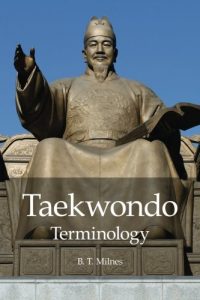A Taekwondo instructor should not be referred to as ‘sensei’ because ‘sensei’ is a Japanese term that’s used in Karate. Taekwondo is a Korean martial art, and thus uses Korean terminology.
The correct name for an instructor in Taekwondo is 사범 sabom (which is pronounced like sah-bom, not say-bom).
If you want to ask your Taekwondo instructor a question, you should add the suffix 님 nim (pronounced like neem). This is a suffix in Korean that’s added to titles. So you would say ‘Sabomnim, can you teach me the form Wonhyo?’
Korean and Japanese have a lot of shared words. Often these are words that have been imported from Chinese. Where a word that exists in Korean also exists in Japanese (or vice versa), that word is known as a cognate. The two words have the same origin, and generally the same meaning in modern Korean and Japanese, but they will generally have a different pronunciation.
The Japanese word sensei does have a cognate in Korean – 선생 sonsaeng (pronounced sohn-seng). However, the way the word is used is different. Sonsaeng means ‘teacher’ in Korean, and is normally used to refer to a teacher in an academic setting. It’s also used as a general word to refer to other people – particularly people you’ve never met before or don’t know well. You can use the word sonsaeng in Taekwondo, but generally only to refer to other students who are at a similar or higher level than you, rather than your instructor.
Get some Taekwondo merch!
Want to learn more?

If you'd like to learn more about the Korean terminology used in Taekwondo, consider buying this book: Taekwondo Terminology. It contains an extensive dictionary of terms used in Taekwondo, as well as explanations on how to pronounce Korean words, and aspects of Korean grammar.








